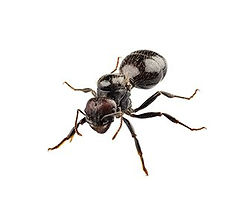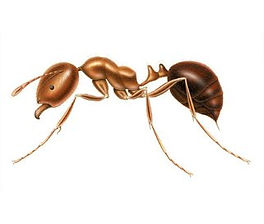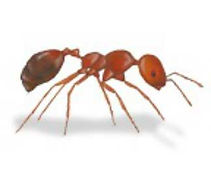
We will either find a way or make one.
1 784 455 1897/1 784 526 8086
Ants
-
Ants have been found on nearly every landmass on the planet. Only Antarctica and some inhospitable islands do not have ants.
-
Ants have been around for approximately 130 million years and examples have been found encased in amber from that time.
-
Ants are part of the Formicidae family and are related to wasps and bees.
-
There are about 12,500 identified species of ants and some experts guess that there may be as many as 22,000 species on the planet.
-
Ants have exoskeletons that make their bodies very strong. This allows them to carry many times their own weight, even when walking upside down.
-
It’s estimated the total weight all of the ants in the world would equal the weight of all of the humans on the planet!
Another fact about ants is they form highly socialized colonies and have a division of labor. There is usually a queen that produces the eggs, the workers who tend to the eggs and queen and soldiers who defend the nest. Many species also have drones that head out to find food. Recent studies have shown that ants can divide up their labor to accomplish tasks like moving a large object. One ant can take a leader role and control and direct the other ants to accomplish the task.
Most species of ants have very poor eyesight and use other senses to navigate and to communicate. For example, most ants leave chemical trails to food sources and use pheromones to communicate with each other.
Scientists have used various methods to determine that ants have internal pedometers they use to find food sources and return to the nest. It is also believed have internal compasses to help them navigate.
The bullet ant, found in rainforest areas in South America, has the most painful sting of any creature on earth according to the Schmidt sting pain index.
Lifecycle
-
Larva hatches out of the egg as a white grub which is narrower towards the head. They are fed by the adults.
-
The larva pupates and appears creamy-white, looking similar to an adult. Sometimes they have a protective silk cocoon around them.
-
The adult emerges with the three defined body sections: head, thorax and abdomen.
-
The length of time between the egg stage and ants emerging as adults can take 6 weeks or more; it depends on a variety of factors such as the species of ant, the temperature and the availability of food.
-
Fertilised eggs become female, unfertilised become males.

Habits
-
These ants are regarded as a nuisance and scavenge in kitchens, garbage and also dog excrement, therefore potentially spreading diseases such as salmonella.
-
'Common Ants' include the intensely black 'Black House Ants', and they are attracted to sweets.
-
The light yellowish brown 'Coastal Brown Ant' prefers to feed on meat products and grease.
-
The most effective control measure is to find the colony and treat it.
Black House Ant
(Ochetellus)
Appearance
-
Shiny and black.
-
2.5 - 3mm long.
Fire Ant
(Solenopsis spp)
Appearance
-
Queens 5/8" long.
-
Workers 1/8"-1/4" long.
-
Coppery–brown on the head and body, with a darker abdomen.
-
Solenopsis has a very distinctive two–segment antennal club, which is most visible in the front view of the female reproductive ant.
Lifecycle
-
After swarming from the nest and mating, the queen searches for a suitable spot to lay her eggs. Once found, she can lay up to 125 eggs in late Spring.
-
Larvae hatch within 8 to 10 days, and the pupal stage lasts for 9 to 16 days.
-
Larvae feed on secretions from the queen’s salivary glands and broken down wing muscles until the first worker ants emerge. After this first batch of larvae moult into workers the queen’s role returns to egg laying – she can lay up to 1500 per day. Worker ants continue with larval care, nest building and food foraging.
-
Fertile males are produced later in the season.

Habits
-
Foraging workers diet consists of dead animals, including insects, earthworms, and vertebrates. Workers also collect honeydew and forage for sweet food, proteins, and fats.
-
Swarming characteristics – mating between queens and fertile males takes place on the wing mid to late Summer. Males perish after mating.
-
Nest locations can be a mound of up to 40 cm or next to objects found on the ground, e.g. logs.
-
If aggravated, these react aggressively and can inflict a painful sting, resulting in a pustule some 48 hours later.
-
These ants are a major agricultural and urban pest, destroying crops and invading residential areas both outdoors and indoors.
Singapore Ant
(Monomorium destructor)
Appearance
-
2-3mm.
-
Light brown with darker posterior abdomen.
-
Head flattened and blocky.
Lifecycle
-
The ant’s life cycle passes through egg, larva, pupa and adult phases.

Habits
-
Eats a variety of food materials, including protein and sugar-type materials.
-
Typically nests in and around buildings, in cracks, crevices, wall cavities, behind skirting, under paths etc.
-
The most problematic feature of this pest is its attraction to plastics in electrical, irrigation and other equipment.
-
It has a fairly painful sting.
Sugar Ant
(Camponotus app)
Appearance
-
This species vary greatly in shape, size and colour.
-
Range from 2.5 to 15 mm, and are some of the most often seen ants due to their size and often bright in colouring.
Lifecycle
-
The ant’s life cycle passes through egg, larva, pupa and adult phases.

Habits
-
Often nests in a variety of sites ranging from holes in wood to the roots of plants, twigs of trees and shrubs, between rocks or in the soil.
-
They can also be seen during the day however, they are most active at night.
-
They are unable to sting, but they do possess strong mandibles which can bite. In self-defense these ants are also able to spray acid from their abdomens to deter predators.
-
They feed on dead and lives insects, household waste and are attracted by sweet food.
-
They rarely enter houses.
Information about Ants
Ants can live almost anywhere. There are about 10,000 species of ants. Within each species there are usually many different types. Ants are social insects that live in colonies. Ant colonies include one or more queen, as well as workers, eggs, larvae, and pupae. The worker ants maintain their developed structures known as nests. Nests protect the ants against their enemies, offer some protection against weather, and are often placed close to water and food sources. Some ant species nest in the ground, often under concrete or slabs. Some species are found in wood, such as fence posts, dead logs, hollow trees, or within buildings. Ants cannot eat wood like termites can because they can’t digest cellulose.
The body structure of an ant is typical of almost all insects: six-legged, with a tough, outside skeleton, called the exoskeleton which encases its three separate body parts. It also has two multi-purpose antennae and unlike most other insects, ants have a waist, making them easier to identify. The ant’s exoskeleton protects it from the weather, injury and water loss. Insects with external skeletons have great strength for their size which allows them to carry objects many times their weight.




